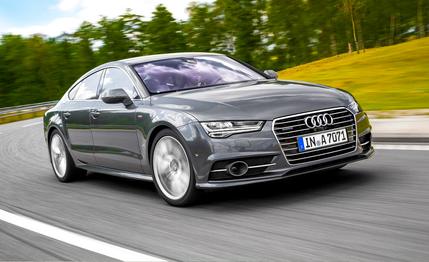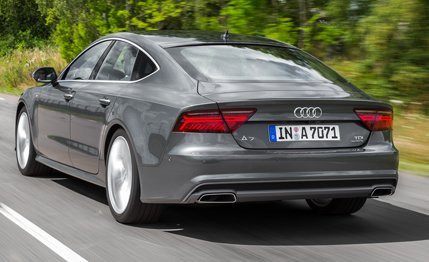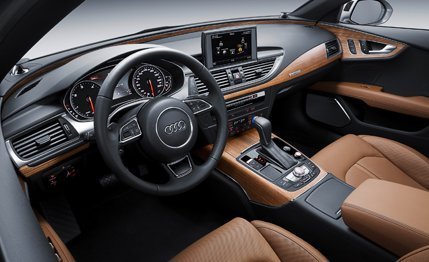
 First Drive Review
First Drive Review
Audi has faced criticism about its cars all looking the same in different sizes, like matryoshka, those Russian nesting dolls. Consider the A7 a counterpoint. A large hatchback sedan based on the A6, it doesn't look like the A6 or even the not-for-the-U.S. A5 Sportback. Every crease is its own, and the overall shape is informed by 1970s and 1980s sports cars.
The A7 is one of our favorites, making three appearances on our 10Best list and winning separate comparison tests against the BMW 640i Gran Coupe and the Mercedes-Benz CLS550. As with the A6 and S6, Audi has upgraded the 2016 model, available from the first quarter of 2015. The front end looks more contemporary with a subtler grille and slimmer LED headlights. Restyled taillights present a more horizontal and angular look above rectangular exhaust outlets.


Audi offers two engines for the U.S. The 3.0-liter V-6 TDI diesel with an output of 240 horsepower and 428 lb-ft of torque carries over unchanged; the 3.0-liter V-6 TFSI supercharged gasoline engine now makes 330 horsepower, up 20, though with the same 325 lb-ft of torque. Either one mates to Quattro all-wheel drive and a ZF-sourced eight-speed automatic transmission.
While we lament that Audi won’t send its awesome 320-hp twin-turbo BiTDI to the U.S., the 240-hp diesel launches the A7 on a wave of torque and builds speed with reassuring force. It does just about everything perfectly while emitting little more than a subdued growl. There is ample passing power; the extra thrust of the high-performance diesel sold in Europe comes mostly at triple-digit autobahn speeds rarely encountered in America.
The supercharged gasoline V-6 doesn't feel quite as strong off the line, but once rolling, it is clearly more responsive than its TDI sibling—or most any turbocharged model in its segment. The soundtrack is silky-smooth, not menacing. The trade-off for its supreme manners is fuel consumption far thirstier than that of the TDI that recorded 30 mpg in our 2014 test.
Audi offers only the ZF eight-speed torque-converter automatic in the U.S., while buyers in other markets can choose a seven-speed dual-clutch automatic transmission. We’re told that Americans prefer the torque overload at step-off. The automatic is fine for the diesel, but the eager supercharged gasoline engine pairs nicely with the dual-clutch gearbox Audi reserves for the sportier S6/S7 models here. That said, the ZF unit is a benchmark automatic, and no direct competitor offers a dual-clutch—you’d have to stretch the budget at least $10,000 to nab the DCT in the base Porsche Panamera.


We’ve praised the A7's competent chassis before, and it still impresses. From the light steering to the precise turn-in and the way its suspension shrugs off uneven surfaces, few cars can match it in spirited driving. It's comfortable, too, and quiet. For 2016, the excellent cabin is further improved with an upgraded infotainment system and fresh décor. Unfortunately, Audi hasn't fixed the poor integration of the head-up display; the massive box atop the dashboard is impossible to overlook and so obtrusive that we'd rather not have the system at all.
Prices will remain close to those of the current model, which begins at $66,825. For what the A7 offers, including its stunning looks, that's not a bad deal. But if the hatchback shape isn’t for you, check out the updated A6. It can do everything just as well for thousands less.